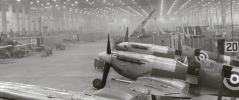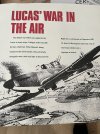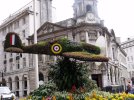https://media.iwm.org.uk/ciim5/39/584/large_000000.jpg The Prime Minister Winston Churchill observes a female riveter working on a Supermarine Spitfire at the Castle Bromwich factory in Birmingham, England, on 28 September 1941. By kind permission of IWM No copyright infringement is intended.
-
Welcome to this forum . We are a worldwide group with a common interest in Birmingham and its history. While here, please follow a few simple rules. We ask that you respect other members, thank those who have helped you and please keep your contributions on-topic with the thread.
We do hope you enjoy your visit. BHF Admin Team
You are using an out of date browser. It may not display this or other websites correctly.
You should upgrade or use an alternative browser.
You should upgrade or use an alternative browser.
Castle Bromwich Spitfire Factory
- Thread starter aggie2347
- Start date
https://media.iwm.org.uk/ciim5/39/839/large_000000.jpg Firefighters hose water through the glassless windows of the shell of a building on Small Brook Street, which was destroyed by fire after an air raid, c 1940. A pile of rubble and debris is clearly visible in the foreground. By kind permission of IWM No No copyright infringement is intended.
My mother worked at the Spitfire factory in Castle Bromwich, she did not speak about her work there but something in the old grey matter seems to recall that she worked on the aircraft wings. She left in 1943 to give birth to me. I would love to find out more information about her if anyone could help me.
I know we all love our Spitfire history on BHF, so here’s a treat from The Historic England Blog. There is some super images of the Castle Bromwich Aeroplane Factory along with some background information too.
The story of the spitfire is indeed a remarkable story of achievement and endeavour. One that should be told, so that we can celebrate our achievement and learn from our failures.
Like most of these stories of achievement, in truth it is a tail of collaborative working and the efforts of many people. I am quite disappointed to read that while the female factory workers have been acknowledged some of the key engineering and design contributions were made by women.
Beatrice Shilling was a British aeronautical engineer and was one of the early pioneers in her field. We also have the untold story of Hazel Hill a 13 year old who helped redesign the Spitfire from 4 to 8 guns, along with countless women spitfire pilots who played a key role is the distribution and movement of spitfire around the country.
The story of the spitfire is indeed a remarkable story of achievement and endeavour. One that should be told, so that we can celebrate our achievement and learn from our failures.
Like most of these stories of achievement, in truth it is a tail of collaborative working and the efforts of many people. I am quite disappointed to read that while the female factory workers have been acknowledged some of the key engineering and design contributions were made by women.
Beatrice Shilling was a British aeronautical engineer and was one of the early pioneers in her field. We also have the untold story of Hazel Hill a 13 year old who helped redesign the Spitfire from 4 to 8 guns, along with countless women spitfire pilots who played a key role is the distribution and movement of spitfire around the country.
Richard Dye
master brummie
Mort, wonderful story and read! So much clever innovation so long ago. I just wonder if we could respond (anywhere) as quickly and deliberately today!I know we all love our Spitfire history on BHF, so here’s a treat from The Historic England Blog. There is some super images of the Castle Bromwich Aeroplane Factory along with some background information too.
The story of the spitfire is indeed a remarkable story of achievement and endeavour. One that should be told, so that we can celebrate our achievement and learn from our failures.
Like most of these stories of achievement, in truth it is a tail of collaborative working and the efforts of many people. I am quite disappointed to read that while the female factory workers have been acknowledged some of the key engineering and design contributions were made by women.
Beatrice Shilling was a British aeronautical engineer and was one of the early pioneers in her field. We also have the untold story of Hazel Hill a 13 year old who helped redesign the Spitfire from 4 to 8 guns, along with countless women spitfire pilots who played a key role is the distribution and movement of spitfire around the country.
Thanks for sharing!
oldMohawk
gone but not forgotten
I'm always interested in comments about the Castle Bromwich Spitfire Factory because my Dad worked there during the war. I remember as a young child being taken there to meet him when he came out of the gate. As we waited I used to watch the Spitfires being air tested. An interesting story about a 19 year old women who worked there from
Sample paragraph from her story ...
BBC - WW2 People's War - Building Spitfires at Castle Bromwich, Birmingham
Another time when there was bombing during the day, my mother sent my brother Jack to the factory to see if ...
www.bbc.co.uk
Sample paragraph from her story ...
I remember going to work to start the 6am shift one morning and D Block had been bombed the night before. The clothes, shoes and gas masks of the workers from D Block were piled in heaps between A and C Blocks. They were wet from the water used by the fire brigade to fight the fires. You could see bodies still in the girders of the roof of the factory. It is a sight that you never forget. It was after the bombing of D Block that they altered the working hours to three shifts, 6am to 2pm, 2pm to 10pm and 10pm to 6am.
There are many real horror stories like that from the war. Not Birmingham, but my mother told me of how a friend, after the big raid on Tangmere airfield which did a lot of damage at the height of the B of B, had to go round collecting bits of bodies and putting them in sacks
Richard Dye
master brummie
Mort, that is a great film...........Did not really know much about this but developing those curves (and getting them right) is no small task!
Richard Dye
master brummie
Just read the Wiki, more interesting background about her life and challenges at school that she overcame!Just watched the film - amazing story!
I noticed one of her sons had a slight Midlands accent - checking out on Wiki I see her and her husband moved to Wednesbury where she set up a children's health clinic.
Covroad
master brummie
I have a Lucas WW2 memorial book titled Lucas at War , the attached is reference to the Spitfire and the contribution Lucas made to the building of the plane.
I can if there is a demand scan the complete book and upload for reference.
I can if there is a demand scan the complete book and upload for reference.
Attachments
mw0njm.
A Brummie Dude
Castle Bromwich
The largest purpose built aircraft factory of World War II producing the iconic Vickers Supermarine Spitfire Fighter and the Avro Lancaster Bomber.
mw0njm.
A Brummie Dude

Castle Bromwich (1937-1940)
1935-1938 The Shadow Factory Scheme Long before the start of hostilities the vulnerability of the existing aircraft factories to enemy attack had been recognised. Many of the factories, like Superm…
 supermariners.wordpress.com
supermariners.wordpress.com
castle brom spitfire

Richard Dye
master brummie
Wonderful picture Pete!
Castle Bromwich (1937-1940)
1935-1938 The Shadow Factory Scheme Long before the start of hostilities the vulnerability of the existing aircraft factories to enemy attack had been recognised. Many of the factories, like Superm…supermariners.wordpress.com
castle brom spitfire
View attachment 175232
Very interesting article!
Castle Bromwich (1937-1940)
1935-1938 The Shadow Factory Scheme Long before the start of hostilities the vulnerability of the existing aircraft factories to enemy attack had been recognised. Many of the factories, like Superm…supermariners.wordpress.com
castle brom spitfire
View attachment 175232
The Imperial War Museum has just released a super video covering the development of the Merlin engine.
The most important engine of the Second World War?
Enjoy.
The most important engine of the Second World War?
Enjoy.
Excellent Vid but what the presenter left out was the fact that the Merlin engine went on to power post war airliners such as the Avro York and the disastrous Tudor. Probably best known were the Merlin powered North Stars, named Argonauts by BOAC and some were sold on to British Midland,one of which crashed at Stockport in 1967
I didn't know it was a purpose-built factory. As I was born after the end of WW2 my knowledge of the Spitfire Factory was from the tales told to me by my ex father-in-law (I had assumed it was a combination of the 'local' industry - Wolseley commercial engines, Fisher and Ludlow body-works, Fort Dunlop tyres and rubber hoses, Lucas electricals - that prompted the production, rather than a purpose-built building).Castle Bromwich
The largest purpose built aircraft factory of World War II producing the iconic Vickers Supermarine Spitfire Fighter and the Avro Lancaster Bomber.www.baesystems.com
His tale is as follows.
As a young lad during the war, my ex father-in-law would walk from his home (Erdington I think) to Castle Bromwich, to sit on Pimple Hill (which is still there, alongside the -newish to me- A452 Collector Road) which looked over Castle Bromwich aerodrome (where Castle Vale Estate now stands). His story was of sitting there watching the newly made spitfires being rolled out of the factory and lined up on one side of the aerodrome. The test pilot would then come along, climb into the first in the line, taxi along the runway, fly around in a circle and land again, parking the plane on the other side of the airfield. He would continue doing this, taking the next in line, flying it once around the airfield, landing and then parking in the new line, until all 'new' planes had been flown. He said that this was obviously 'testing' i.e. if it flew and landed ok it was ready for the war! On other days, pilots would arrive to take the 'tested' planes off to their allotted squadrons.
Covroad
master brummie
My post#14 on the construction of the Spitfire makes reference to Lucas’s engineering (electrical and instrumentation) contribution to the Spitfire, there is a memorial booklet that Lucas produced to commemorate WW2 titled ‘Lucas at War‘.
As a youth, one of the older players in a cricket team I use to play for in Yardley would tell us a similar stories of watching the Spitfires taking off and landing during test flights and the distinctive roar of the RR engine (Merlin)
He told us the test pilots would use the stacks / towers at Hams Hall power station as a visual reference point when returning to land at Castle Bromwich as the could see the smoke from the towers above the clouds when flying.
A link attached to give more information on the fantastic Spitfire plane
https://dingeraviation.net/spitfire/spithome.htm
(Source https://dingeraviation.net/spitfire/spithome.htm, site accessed 11/3/2023 09.07 am)
As a youth, one of the older players in a cricket team I use to play for in Yardley would tell us a similar stories of watching the Spitfires taking off and landing during test flights and the distinctive roar of the RR engine (Merlin)
He told us the test pilots would use the stacks / towers at Hams Hall power station as a visual reference point when returning to land at Castle Bromwich as the could see the smoke from the towers above the clouds when flying.
A link attached to give more information on the fantastic Spitfire plane
https://dingeraviation.net/spitfire/spithome.htm
(Source https://dingeraviation.net/spitfire/spithome.htm, site accessed 11/3/2023 09.07 am)
Richard Dye
master brummie
An excellent link, well worth reading written very well! Thank you for sharing!My post#14 on the construction of the Spitfire makes reference to Lucas’s engineering (electrical and instrumentation) contribution to the Spitfire, there is a memorial booklet that Lucas produced to commemorate WW2 titled ‘Lucas at War‘.
As a youth, one of the older players in a cricket team I use to play for in Yardley would tell us a similar stories of watching the Spitfires taking off and landing during test flights and the distinctive roar of the RR engine (Merlin)
He told us the test pilots would use the stacks / towers at Hams Hall power station as a visual reference point when returning to land at Castle Bromwich as the could see the smoke from the towers above the clouds when flying.
A link attached to give more information on the fantastic Spitfire plane
https://dingeraviation.net/spitfire/spithome.htm
(Source https://dingeraviation.net/spitfire/spithome.htm, site accessed 11/3/2023 09.07 am)
Richard Dye
master brummie
That is a genuine Hot Rod!and some cars
Rolls Royce with Spitfire Merlin V12 engine
JulieJacqueline
New Member
 This was my nans works ID card for AVRO (Spitfire at Castle Bromwich) she worked their during the war and had many stories to tell incluing the lunch time dance bands and seeing the plans pushed across the road so they could reach the runway. Previous to Spitfire she had worked at Buttons - sewing the fine buttons for dress uniforms. We lost Marian Wagg in June this year less than 2 months before her 99th birthday she was a proud brummie and we were equally proud of her
This was my nans works ID card for AVRO (Spitfire at Castle Bromwich) she worked their during the war and had many stories to tell incluing the lunch time dance bands and seeing the plans pushed across the road so they could reach the runway. Previous to Spitfire she had worked at Buttons - sewing the fine buttons for dress uniforms. We lost Marian Wagg in June this year less than 2 months before her 99th birthday she was a proud brummie and we were equally proud of her

